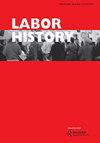Generational politics: revolution versus production in Shanghai factories in the early years of the people’s republic of China
IF 0.7
4区 管理学
Q1 HISTORY
引用次数: 0
Abstract
ABSTRACT Following the takeover of Shanghai, the Chinese Communist Party (CCP) used ‘generation’ as a key regulatory technique to mold the working class into a reliable leading class. From 1949 to late 1952, through a series of political movements, junior workers (qinggong), who had been professionally incompetent, were granted the identity of ‘activists’ and elevated to a politically superior position over senior workers (lao gongren). From late 1952, however, the CCP became reliant on skilled senior workers after the consolidation of the new order and the launch of industrialization. During the handling of the 1956–1957 Shanghai Strike, the CCP protected senior workers and blamed junior workers, thus finalizing the logic of ‘junior workers learning from senior workers,’ which persisted until the eve of the Cultural Revolution. This article argues that the CCP strategically divided the working class into junior and senior workers and employed generational politics as a tool for regulating the working class.代际政治:建国初期上海工厂的革命与生产
摘要接管上海后,中国共产党将“代”作为一种关键的调控手段,将工人阶级塑造成一个可靠的领导阶层。从1949年到1952年底,通过一系列的政治运动,专业上不称职的初级工人(青工)被赋予了“积极分子”的身份,并被提升到了比高级工人(老工)更高的政治地位。然而,从1952年底开始,在新秩序巩固和工业化开始后,中国共产党开始依赖熟练的高级工人。在1956年至1957年上海大罢工的处理过程中,中共保护了高级工人,指责了初级工人,从而最终确定了“初级工人向高级工人学习”的逻辑,这种逻辑一直持续到文化大革命前夕。本文认为,中共从战略上将工人阶级分为初级工人和高级工人,并将世代政治作为规范工人阶级的工具。
本文章由计算机程序翻译,如有差异,请以英文原文为准。
求助全文
约1分钟内获得全文
求助全文
来源期刊

Labor History
Multiple-
CiteScore
1.00
自引率
28.60%
发文量
44
期刊介绍:
Labor History is the pre-eminent journal for historical scholarship on labor. It is thoroughly ecumenical in its approach and showcases the work of labor historians, industrial relations scholars, labor economists, political scientists, sociologists, social movement theorists, business scholars and all others who write about labor issues. Labor History is also committed to geographical and chronological breadth. It publishes work on labor in the US and all other areas of the world. It is concerned with questions of labor in every time period, from the eighteenth century to contemporary events. Labor History provides a forum for all labor scholars, thus helping to bind together a large but fragmented area of study. By embracing all disciplines, time frames and locales, Labor History is the flagship journal of the entire field. All research articles published in the journal have undergone rigorous peer review, based on initial editor screening and refereeing by at least two anonymous referees.
 求助内容:
求助内容: 应助结果提醒方式:
应助结果提醒方式:


